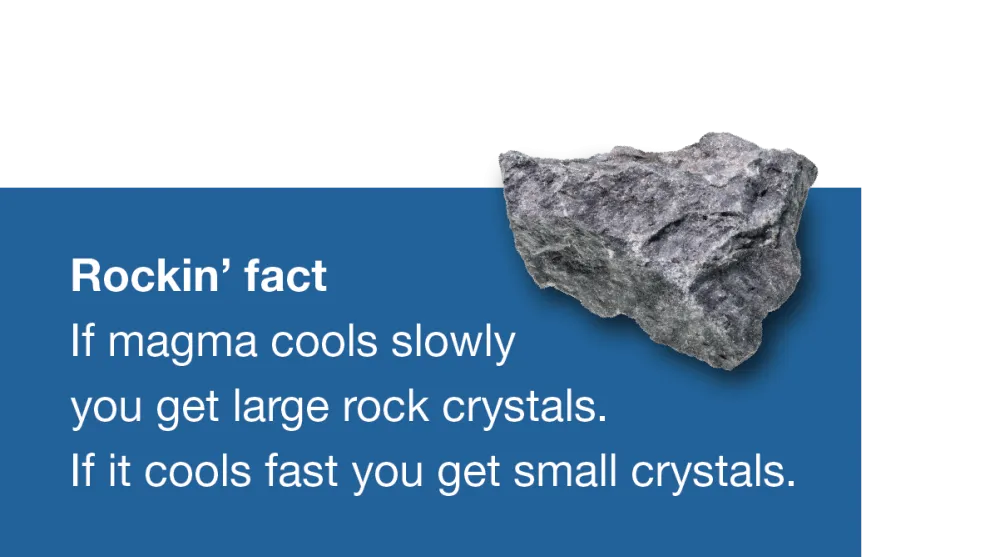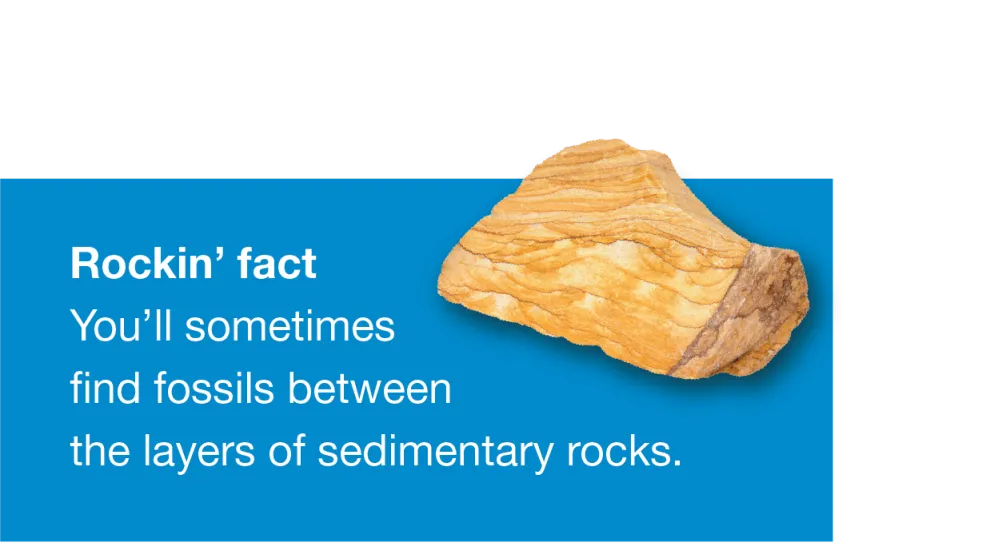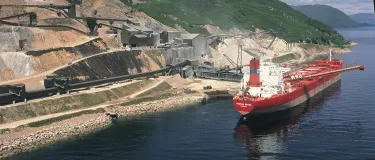What are Igneous, Sedimentary and Metamorphic Rocks?

Understanding the nature of these three types of rocks will give you a real insight into the complex and dynamic building blocks which make up our planet.
Igneous, sedimentary and metamorphic rocks are not just static entities. Through a series of processes known as the rock cycle, they are constantly undergoing transformation, playing a crucial role in shaping the landscape we see today.
The three main types of rocks we’re looking at each have unique characteristics and formation processes, offering insights into the Earth's past and present.

The rock cycle
The rock cycle is a continuous process describing the transformation of rocks through various geological stages. It begins with igneous rocks, formed when molten magma cools and solidifies. These rocks can be pushed deep under the Earth's surface, where high pressure and temperature transform them into metamorphic rocks.
Alternatively, weathering and erosion break down all rock types into small particles that accumulate and compact over time, forming sedimentary rocks. These layers of sedimentary rock can also undergo heat and pressure, leading to metamorphic rock formation.
Additionally, both sedimentary and metamorphic rocks can be subducted into the Earth's mantle, melting into magma, which may eventually cool and crystallise to form new igneous rocks.
This cycle, driven by Earth's internal heat and external forces like weathering, illustrates the dynamic and ever-changing nature of our planet's geology, highlighting the interconnectedness and transformation of rock materials over time.
Igneous rocks

Igneous rocks are formed from the cooling and solidification of magma or lava. This process can occur beneath the Earth's surface, resulting in intrusive igneous rocks, or on the surface as extrusive igneous rocks.
Intrusive igneous rocks
Intrusive igneous rocks form when magma cools and solidifies beneath the Earth's surface. This slow cooling process allows for the growth of large, visible crystals.
Granite is a prime example, known for its coarse-grained texture and wide use in construction due to its durability. Diorite and gabbro are other examples, each with distinct compositions and uses.
Intrusive igneous rocks are often found in mountain ranges and deep underground, forming the cores of continents.
Extrusive igneous rocks
Extrusive igneous rocks form when lava cools rapidly on the Earth's surface. These rocks often have a fine-grained texture, as the rapid cooling doesn't allow large crystals to form.
Basalt, a common extrusive rock, forms the majority of the ocean floor and is known for its dark colour and fine-grained texture. Rhyolite and andesite are other examples, as is Pumice, known for its unique for its bubbly texture, which is due to the rapid escape of gases during cooling.
Extrusive igneous rocks are often found in volcanic regions and can form spectacular landscapes.
We use igneous rocks to manufacture our high PSV (polished stone value) aggregates or the high specification products. A good example is our Track Ballast product, which can only be made from igneous rocks, and we service it from our Glensanda quarry. In addition, Bardon Hill granite which has a high (60)PSV is used within high specification asphalt products and road surface dressing.
Sedimentary rocks
Sedimentary rocks are formed from the accumulation of sediments. These sediments can be fragments of other rocks, organic material or minerals dissolved in water. Sedimentary rocks are classified into three main types: clastic, chemical, and organic.
Clastic sedimentary rocks
Clastic sedimentary rocks, like sandstone and shale, are formed from the mechanical weathering debris of other rocks. These rocks are often layered and can be a rich source of fossils. Conglomerate and breccia are other examples, known for their varied compositions and textures. Clastic rocks often record the Earth's history, preserving evidence of past environments, climates and life forms.

Chemical sedimentary rocks
Chemical sedimentary rocks form when minerals are deposited in solid form from a solution. Limestone, which often contains fossils, is a common example, formed from the skeletal remains of marine organisms. Dolomite and chert are other types of chemical sedimentary rocks. These rocks can form extensive deposits, often in marine environments, and are important sources of minerals.
Organic sedimentary rocks
Organic sedimentary rocks, such as coal, are formed from the accumulation of plant or animal debris. Coal, for instance, is formed from the remains of plants and is a vital energy resource. Peat and oil shale are other examples of organic sedimentary rocks, each significant for their organic content and energy potential. These rocks are crucial for understanding past life and ecosystems, as well as for their economic value.
Sedimentary rocks, because of the different ways that they have formed, can be very varied. Some deposits often have very rounded granules, which means they will allow water to run through easier. This is why we use sedimentary deposits for products like our specialists filtration sands, which are supplied from our industrial sand quarries. Limestone rock is supplied for a large range of products from asphalt to ready mix and precast concrete products. We have multiple limestone quarries, but Torr Quarry in Somerset is our largest.
Metamorphic rocks

Metamorphic rocks are formed from the transformation of existing rocks under the influence of high heat or pressure (or both) without the rock melting. This process can result in either foliated rocks or nonfoliated rocks.
Foliated metamorphic rocks
Foliated metamorphic rocks, such as gneiss and schist, are characterised by their layered or banded appearance. This texture is the result of high pressure that aligns the minerals in the rock into parallel layers. Slate and phyllite are other examples, each with distinct foliation and uses. These rocks often form in regions of intense tectonic activity and can provide valuable information about the conditions deep within the Earth.
Nonfoliated metamorphic rocks
Nonfoliated metamorphic rocks, like marble and quartzite, do not have a layered appearance. Marble, formed from limestone, is prized for its beauty and is extensively used in sculpture and architecture. Quartzite, originating from sandstone, is known for its hardness and resistance to weathering. These rocks are often used in construction and decorative arts due to their aesthetic and physical properties.
Metamorphic rock is a hard rock, having gone through a similar heating process just like the igneous rock. We use metamorphic rocks for all sorts of applications and most of our products can be manufactured from this type of rock: from our MOT Type 1 products which is used in general construction and road building , to the Armourstone used for coastal defence.
Conclusion
Igneous, sedimentary and metamorphic rocks play a key role in various industries, serving as building materials, energy sources and even as gemstones. Their diverse applications and fascinating formation processes make them an integral part of our world, shaping not just the physical landscape but also human society. Understanding these three types of rocks provides a window into the Earth's past and a key to its future.
Frequently Asked Questions
Intrusive igneous rocks form when magma cools and solidifies beneath the Earth's surface. This slow cooling process allows large crystals to form, resulting in a coarse-grained texture. Granite is a classic example of an intrusive igneous rock.
On the other hand, extrusive igneous rocks form when lava cools rapidly on the Earth's surface. The quick cooling prevents large crystals from forming, often resulting in a fine-grained or glassy texture. Basalt and obsidian are typical examples of extrusive igneous rocks.
Clastic sedimentary rocks are formed from the mechanical weathering debris of other rocks and are often characterised by their grain size and sorting. Common examples include sandstone and shale.
Chemical sedimentary rocks form from minerals precipitating out of solution, often in marine environments. They typically have a crystalline structure and include rocks like limestone and dolomite.
Organic sedimentary rocks are formed from the accumulation of plant or animal debris. Coal, formed from plant remains, is a prime example of an organic sedimentary rock.
Foliated metamorphic rocks exhibit a layered or banded appearance, which is a result of high pressure and temperature that aligns the minerals in the rock into parallel layers. Examples include slate and gneiss.
Non-foliated metamorphic rocks, on the other hand, do not display this layering. They are typically formed under conditions where pressure is not uniformly applied or where the original rock is composed of minerals that do not form elongated crystals. Marble and quartzite are examples of non-foliated metamorphic rocks.
Rocks play a vital role in both the economy and the environment. Economically, they are essential in construction (granite, limestone), energy production (coal, uranium) and manufacturing (clay for ceramics, quartz for glass).
Environmentally, certain rocks can help in carbon sequestration (basalt), soil formation and nutrient cycling (various sedimentary rocks) and water filtration (sandstone). Additionally, rocks are crucial in natural habitats, providing the foundation for ecosystems and influencing landscapes.
The most common rock-forming minerals are those that make up the Earth's crust. These include quartz, feldspar, mica, amphiboles, pyroxenes, olivine, calcite and clay minerals. Quartz is abundant in both igneous and metamorphic rocks, while feldspar is the most common mineral in the Earth's crust. Micas, amphiboles and pyroxenes are typically found in igneous rocks. Calcite is a primary component of sedimentary rocks like limestone, and clay minerals are predominant in shale.







